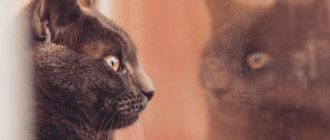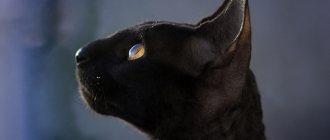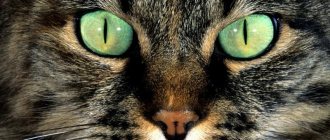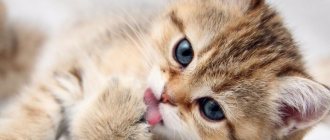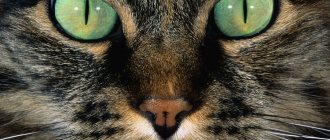Whiskered pets are the most famous warm-blooded dormouse. Their waking time is only 8-12 hours. For the rest of the day, they doze, curled up or stretched out like a sausage. Many of them snore, make funny sounds, move their mustaches and even move their paws.
All these sounds and movements confirm the presence of dreams, but what exactly cats dream about is a big mystery. There is quite a bit of research on this fascinating topic, but some questions have already been answered.
Length of cat sleep
The younger the pet, the longer he sleeps. Newborn kittens spend almost 23 hours a day in the kingdom of Morpheus. They only wake up to feed.
As you get older, your sleep duration gradually decreases. By 4-5 months, it is finally synchronized with the average, that is, 12-16 hours a day. The next change is observed only in old age, when the animal needs more time to restore its strength.
Are there any cases when you need to contact a veterinarian?
You should sign up for an examination at the veterinary clinic in 2 cases: when the cat sleeps less or more than usual. The most common cause of cat insomnia is stress, but unless there is an obvious cause for concern that you can control, an examination by a veterinarian is a must.
Please note that in most cases, pathology is easily suspected based on accompanying signs. If your pet has a fever, suffers from vomiting or frequent nightmares, then first of all it should be checked for head injuries and tumors.
The world of dreams still remains a mystery, but there is no doubt: even our pets see unusual images. Some features of this phenomenon are identical in humans and animals, so you should not give in to another temptation to alarm a sleeping cat. Such an action can destroy a series of pleasant pictures or aggravate the perception of a nightmare.
The article is for informational purposes only!
Source
Phases of falling asleep
Despite the surprisingly long duration of sleep, it cannot be said that all this time cats are completely immersed in the world of dreams. Most of the time they remain responsive to stimuli, which is easily confirmed by the frequent purring of a disturbed dormouse.
The activity of the brain and other important organs depends on the phase of falling asleep. Like people, there are only two of them:
- Fast or superficial. Essential for getting ready for bed. Lasts up to 15 minutes. When dozing, the animal is tense and sensitive to any noise. In case of danger, it will easily run away or attack the offender.
- Slow or deep. Accompanied by complete relaxation of the muscles and periodic twitching of the tip of the tail and whiskers. An animal awakened during this phase needs time to recover.
In humans, most of the dreams occur in the fast phase. They are also recorded in slow motion, but they are always shorter and less emotional.
Should I wake my cat during a nightmare?
No, don't. Do not prevent the animal from living a normal, natural life. Dreams (even nightmares) are an integral part of the body’s life. As we know, cats dream in the REM phase. There is no need to interrupt this cycle, let it end in a “normal” way. There is a risk that your pet will become very scratchy, not to say aggressive, from such a sudden awakening!
So, dear cat lovers, your pets really do dream. Perhaps even colorful. Perhaps you too have some place in them. Just don’t try to extract anything from your cat: most likely, she will immediately refuse! It's better to leave it between us!
Source
Do cats and kittens have dreams – and what kind?
The presence of dreams in the cat family was first proven by the French physiologist Michel Marcel Jouvet. During the experiment, he turned off one of the parts of the brain of a sleeping cat, which is responsible for muscle activity during sleep. After the blocking was removed, the subject showed a master class in hunting while in the fast phase. He completely ignored the real mice offered to him, chasing invisible prey, which served as proof of the presence of vivid images in his head.
What color are dreams?
To begin with, it is interesting to understand whether cats see colored dreams. Scientists do not have a consensus on this issue, but with a high probability, the pictures generated by the sleeping consciousness are no different from the real world. Unlike humans, mustachioed pets see humans only in the green and blue-violet spectrum. They are also available in various shades of gray.
Do cats dream about their owners?
The images that emerge during a dream often resonate with past experiences. Despite the lack of research on this topic, the likelihood of stories involving owners is very high, since they play one of the main roles in the life of their pet.
Do cats have food and household dreams?
All subsequent experiments with the removal of the block showed that the images in the subjects’ heads were associated with very strong emotions. Based on this, scientists have suggested that cat dreams reproduce events from the past that require increased concentration (hunting) and are accompanied by nervous tension (stressful situations).
In addition to memories, human dreams are divided into desires, associated with real experience, and fantasies, associated with the imagination. Mustached pets are characterized by both. Therefore, it is likely that, in addition to chasing mice and unpleasant trips to the veterinarian, they dream of their favorite treats, favorite toys and trips to the country.
Do cats have nightmares?
Having figured out whether cats dream, we can say with confidence that nightmares are not alien to them either. Unpleasant images are accompanied by various groans, nervous tail twitching, growling and hissing. After waking up from a nightmare, the mustachioed pet will easily scratch the first person he sees, or hide under the sofa in horror.
Cat's dream and human's
Let's start with the fact that a cat's sleep has the same cycles as a human's. Purrs also go through the so-called rapid eye movement (REM) sleep phase, during which we all dream - pleasant and not so pleasant. So it is quite logical to assume that cats dream. And they are fundamentally no different in content from ours: cats in their dreams experience what they recently saw, the events they witnessed. Hunting, playing, “socializing” with other cats and all that jazz.
In 1965, French scientists Jouvet and Delorme conducted a very interesting study, during which the so-called pons of the brain was removed from an experimental cat. After the operation, the animal was unable to lie still (well, or twitch a little) during sleep. On the contrary, in a state of sleep the cat walked, and even behaved aggressively! This discovery prompted the researchers to the right idea - in their sleep, cats rethink their experience. And they seem to be able to separate dreams from what they see in reality. Just like you and me.
Is anesthesia also a dream?
Owners who do not know all the nuances of anesthesia often wonder whether cats dream under anesthesia. The answer to this question is easy to obtain if you understand the essence of the procedure.
Anesthetics used during surgery depress vital signs. Because of this, anesthesia is more like an artificial fainting, and not like a dream. Instead of pleasant vigor, the awakened patient feels severe lethargy and weakness.
What indicates that cats have dreams?
In addition to research data, you can take a closer look at the animal when it is looking for a place to lie down. After the start of a full sleep, it becomes noticeable that the eyes are constantly moving, the paws are twitching. You can often see your pet moving or nervously beating its tail. It's interesting to watch the whiskers and ears move.
Perhaps the cat is dreaming of a bowl from which it can eat deliciously. If an animal has access to the street and is walking, we can assume that it is dreaming of scenes from the outside world, a person. Sometimes, even in the deep resting phase, the cat begins to lick itself.
She may hunt or climb trees in her sleep. Sometimes you can even hear the animal making sounds in its sleep. They can also indicate the direction of dreams. If they are purring, then perhaps the animal simply dreams of affectionate owners. Sharp sounds indicate dissatisfaction, and hissing means danger. The cat probably met a dog in a dream.
If animals are not outside, then most often they dream of a house and its inhabitants . Perhaps how the owners play with her or give her delicious food, stroke or comb her. A cat that has given birth to kittens probably sees her babies in her dreams. She can even make calling sounds. If the kittens were taken away, the animal will miss them greatly. There is a high probability that the mother will dream about her babies.
During the mating season, the cat can see gentlemen who are actively courting. At the same time, a sleeping animal can manifest itself in different ways, depending on its sympathies. If the boyfriend doesn’t like him, the cat may even hiss in his sleep. Individuals of the opposite sex sometimes jump up sharply, not fully awake, and look around in surprise. They are probably dreaming of fights at this moment.
At the moment, it has not yet been possible to find out whether cats dream. No dream center has been found in animals. However, judging by the above, we can conclude that they still have dreams.
Why does a cat dream at night - features of deep rest
This sleep phase is accompanied by a change in the nature of the pet’s brain activity:
- increased body temperature;
- mild tachycardia;
- slight increase in pressure.
This is the answer to the question “why does a cat dream at night?” Despite these obvious similarities to human sleep, deep rest in a cat is somewhat different. Their brain doesn't sleep.
Why can cats defend themselves even when they are dreaming at night? It's all about instincts, in particular self-preservation. It allows the animal to react to sudden changes and defend itself earlier than a human.
This is interesting: A breed of cats with tassels on their ears
Awakening
All people know how difficult it is to sleep when you have a nightmare. And we are very grateful to those people who wake us up in time and save us from this horror. Cats also have nightmares. Very often these dreams haunt animals whose past was very difficult. This can even be seen in their behavior. In addition, cats can be sad in their sleep (they meow pitifully, and this meowing sounds like crying or moaning). However, it is not recommended to wake them up. The animal must watch its dream and understand how it will end. If you wake him up, he will become even more frightened, and this fright will negatively affect his health. There are many examples when a cat remained practically uncontrollable for some time after waking up. He bit and scratched, looked at his owners with frightened eyes, and did not allow anyone to approach him. After this, he behaved extremely restlessly in his sleep, and this continued for a long time, since cats spend up to twenty hours sleeping (or rather, not in a dream, but in half-asleep).
Therefore, do not rush to “save” your pet, let him save himself. It's a pity that our pets can't share their impressions. But let’s hope that someday scientists will be able to answer all our questions.
Found a violation? Report content
Secrets of the brain
The brain of cats is similar to the structure of the human brain. There is a separate part in it, which is called the pons and is responsible for paralysis during sleep. That is, the bridge does not allow a person to move the way he does during wakefulness. Scientists managed to turn off the cat's bridge, and during sleep she began to walk and run as she did while in an active state. This proved that cats view dreams in the same way as humans. Therefore, it is not surprising that pets often behave extremely actively in their sleep (many owners can agree that they have repeatedly observed how a cat in a dream “runs away from the enemy” or “catches up prey”, moving its paws in the air).
Anna Popova said that it is too early to take off masks: the coronavirus has not gone away
Doesn’t let go, but doesn’t invite you to marry: how to recognize your partner’s type of affection
Left his family, went to Minsk: how Mireille Mathieu changed the life of Vladimir Gostyukhin
Colorful dreams
Cats have their own palette through which they see the world. For example, they perfectly distinguish all shades of gray. Light will never be confused with bluish, dark. They can distinguish between blue and green colors, and see yellow and purple. There is no information about other tones. As for dreams, most likely, cats also consider colored dreams, but more likely this happens in the same palette that they use in reality.
Pancakes for Maslenitsa should be perfect: how to prepare and filling options
Forgiveness Sunday (March 14): what not to do on the big holiday
The risk of developing atherosclerosis and more: how pancakes with sour cream harm your health
A little about the dream itself
It’s not for nothing that scientists study sleep by connecting sensors and various monitors to sleeping cats, because the sleepiest pets are very similar to people. Based on the results of such studies, it was found that even during rest, cats have high brain activity, no less than during wakefulness. However, not a single living creature can live without sleep, otherwise it is simply impossible to restore the energy expended during the day.
There are several stages of sleep: superficial (fast) and deep (slow). During the surface phase, the body of a living creature prepares for rest. But despite the fact that the animal is preparing for sleep, its nervous excitability is at its maximum. Any rustle or sound during this period of falling asleep leads to the fact that the cat immediately jumps up and is ready to run away or defend itself. Usually the surface phase lasts 10-15 minutes. You can notice how the pet is tense, and the muscles of the neck, head and limbs are in good shape.
But as soon as the deep phase begins, muscle relaxation occurs. It is noticeable how the body becomes limp, the muscles are not in good shape, and the eyeballs, closed by the eyelids, begin to move. It is this eye movement that indicates that the cat is dreaming.
Even if something wakes up a pet that was in a deep sleep phase, it will not jump up and run immediately. Awakening is slow, gradual. If the cat wakes up on its own, you will notice how it lazily and blissfully stretches out and begins to lick itself.
